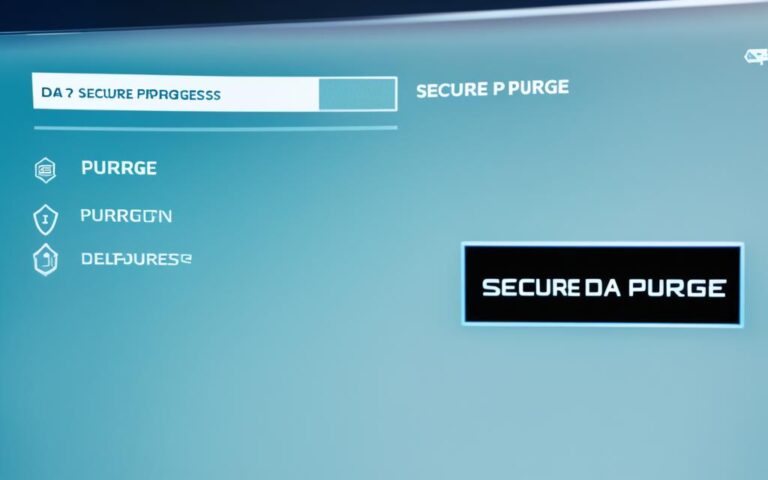The Evolution of Data Destruction Standards and What It Means for Businesses
The need for robust data security measures has become increasingly critical as our world becomes more digitised. Data shredding, which has evolved from paper destruction to modern security practices, plays a vital role in ensuring data security. From the origins of data shredding in paper destruction to the transition to the digital age with hard drive destruction, and the rise of software-based data shredding solutions, data destruction has significantly impacted modern security practices. It helps businesses comply with data protection regulations, consider environmental factors, and enhances overall data security.
As businesses rely more on digital means to store and manage data, the importance of data destruction standards cannot be overstated. The impact of inadequate data destruction can be catastrophic for businesses, resulting in breaches, leaks, and reputational damage. Implementing proper data destruction practices is not only essential for compliance with data protection regulations but also for secure data management and enhanced security.
The Origins of Data Shredding: Paper Destruction
The concept of data shredding can be traced back to the invention of the paper shredder in 1909. Initially used by government agencies and large corporations to securely dispose of sensitive information, paper shredding technology improved over the years. Cross-cut shredders, which cut documents into strips and sliced them horizontally, provided a higher level of security by creating confetti-like pieces that were challenging to reconstruct. Paper destruction laid the foundation for data shredding as a crucial aspect of security practices.
Transitioning to the Digital Age: Hard Drive Destruction
As digital data storage on devices like hard drives and flash drives becomes increasingly prevalent, the need for secure data destruction methods has become more pressing. To address this need, companies now offer services for hard drive destruction using techniques such as crushing, degaussing, and shredding.
Crushing involves applying extreme force to shatter the hard drive into irreparable pieces, rendering the stored information inaccessible. This method ensures that no data can be retrieved from the damaged drive.
Degaussing, on the other hand, utilizes magnets to scramble the data, making it unreadable. By exposing the hard drive to a powerful magnetic field, degaussing permanently erases the information stored on the drive.
Shredding is a method similar to paper shredding. It involves cutting the hard drive into tiny pieces using specialized machinery. These small pieces make it virtually impossible to reconstruct any meaningful data, ensuring secure and complete destruction of the information.
By employing these hard drive destruction techniques, companies can guarantee that sensitive data is disposed of securely and irretrievably. This provides peace of mind to businesses and individuals who want to protect their confidential information from falling into the wrong hands.
| Hard Drive Destruction Methods | Advantages |
|---|---|
| Crushing | – Renders data unrecoverable |
| Degaussing | – Makes data unreadable through magnetic scrambling |
| Shredding | – Reduces the hard drive to tiny, irreparable pieces |
Table: Hard Drive Destruction Methods and Their Advantages
The Rise of Digital Data Shredding: Software Solutions
As physical destruction methods are not practical for devices still in use, software-based data destruction solutions have emerged. Digital data shredding software offers a secure way to delete files without physically destroying devices. This software functions by overwriting data with random characters multiple times, making it impossible to recover the original information. It is crucial for businesses and individuals who need to remove sensitive data from devices before repurposing or selling them.
Digital data shredding software provides a practical and efficient solution for secure file erasure and data wiping. By implementing these software solutions, companies can protect their data from falling into the wrong hands, mitigate the risk of data breaches, and safeguard their reputation.
The Benefits of Digital Data Shredding Software Solutions
Digital data shredding software, also known as data wiping software, offers several advantages:
- Complete Data Erasure: Digital data shredding software ensures that data is permanently erased from devices, reducing the risk of unauthorized access or recovery.
- Time and Cost Efficiency: Software-based data destruction eliminates the need for physical destruction methods, saving businesses time and resources.
- Ease of Use: Data wiping software is user-friendly and can be easily implemented by both businesses and individuals.
- Compliance with Data Protection Regulations: By using digital data shredding software, organizations can meet data protection regulations and avoid penalties.
- Environmentally Friendly: Software-based data destruction helps reduce electronic waste by reusing devices after securely erasing the data.
Implementing digital data shredding software provides a convenient and effective solution for businesses and individuals looking to protect sensitive information. Whether it’s ensuring compliance with regulations or safeguarding customer data, data wiping software offers the necessary security measures.
“Digital data shredding software offers a secure and efficient solution for permanently erasing sensitive information, providing peace of mind for businesses and individuals alike.”
The Future of Digital Data Shredding
With data storage and security becoming increasingly important, the future of digital data shredding looks promising. Advancements in software solutions are anticipated to provide even stronger data wiping capabilities, ensuring data remains irretrievable. Improved algorithms and encryption techniques will enhance the effectiveness and speed of data destruction processes. In addition, the integration of artificial intelligence (AI) technologies may revolutionize data shredding methods, enabling more efficient and accurate deletion of sensitive information.
The Impact of Data Shredding on Modern Security Practices
The evolution of data shredding has significantly influenced the way we protect sensitive information in modern security practices. Data shredding plays a critical role in helping businesses comply with data protection regulations, ensuring both privacy and reputation are preserved. By securely destroying data, businesses can avoid data breaches and safeguard confidential information.
One of the key benefits of data shredding is its impact on compliance with data protection regulations. Regulations such as the General Data Protection Regulation (GDPR) and the Health Insurance Portability and Accountability Act (HIPAA) require organizations to implement measures to protect personal data. Data shredding ensures that data is properly disposed of, reducing the risk of unauthorized access and ensuring compliance with these regulations.
Another aspect that has become increasingly important is environmental consideration. Beyond simply disposing of data, many data and document destruction companies now offer e-waste recycling services. This ensures that not only is the data securely destroyed, but the resulting waste is managed in an environmentally responsible manner.
Advancements in data shredding technology have led to enhanced security measures. Traditional methods such as paper shredding and physical destruction have evolved into more sophisticated software solutions. These software-based data shredding solutions ensure that data is irretrievable by overwriting it with random characters multiple times. As technology continues to advance, so too will the methods used for data shredding, providing even higher levels of security.
To summarize, data shredding has had a profound impact on modern security practices, offering enhanced security, ensuring compliance with regulations, and promoting environmental considerations in data disposal. By prioritizing data shredding, businesses can protect sensitive information, maintain customer trust, and contribute to a more secure digital landscape.
Benefits of Data Shredding in Modern Security Practices:
- Ensures compliance with data protection regulations
- Protects privacy and reputation
- Offers environmentally responsible data disposal
- Enhances overall data security
Comparison of Data Shredding Methods
| Data Shredding Method | Description | Advantages |
|---|---|---|
| Paper Shredding | Physical destruction of paper documents through cross-cut shredding | – Provides a high level of security – Creates confetti-like pieces that are difficult to reconstruct |
| Hard Drive Destruction | Physical destruction of hard drives through crushing, degaussing, or shredding | – Ensures irretrievability of data – Prevents data recovery |
| Digital Data Shredding | Software-based data destruction by overwriting data with random characters multiple times | – Practical for devices still in use – Enhances overall data security |
The Significance of Effective Data Destruction Policies
Effective data destruction policies are crucial in today’s data-driven world. Improper handling of data can result in breaches, leaks, and cyberattacks, causing significant harm to individuals and businesses. Data destruction ensures that unnecessary user information is wiped out properly, making it practically impossible for bad actors to access sensitive data. Proper data destruction practices protect users from the threat of identity theft and financial loss. Consideration for data destruction is essential as data collection and storage continue to expand across various devices and platforms.
The Risks of Inadequate Data Destruction
Without proper data destruction policies and practices in place, businesses leave themselves vulnerable to data breaches and cyberattacks. Inadequate data destruction can lead to sensitive information falling into the wrong hands, resulting in financial loss, reputational damage, and legal consequences. Cybercriminals can exploit improperly disposed devices or recover deleted files, compromising individuals’ privacy and undermining the trust placed in businesses.
“Improper data destruction can have far-reaching consequences for both individuals and organizations. It is essential to have effective data destruction policies in place to safeguard sensitive information and maintain data privacy and security.”
The Importance of Proper Data Destruction Practices
Effective data destruction policies not only protect users and businesses from data breaches but also help ensure compliance with data protection regulations. By implementing secure data destruction practices, businesses demonstrate their commitment to privacy and data management, reinforcing trust with customers, partners, and stakeholders.
Data destruction is especially crucial as data collection and storage continue to expand across various devices and platforms. With the increasing use of cloud computing, mobile devices, and the Internet of Things (IoT), ensuring the proper disposal of data is becoming more complex and challenging. Organizations must establish robust data destruction processes to address these evolving data environments.
The Benefits of Effective Data Destruction Policies
Implementing effective data destruction policies offers several benefits:
- Enhanced Privacy Protection: Proper data destruction ensures the complete removal of sensitive data, protecting individuals from potential identity theft and privacy breaches.
- Reduced Risk of Data Breaches: By securely disposing of unnecessary user information, businesses minimize the risk of data breaches and cyberattacks.
- Compliance with Data Protection Regulations: Effective data destruction practices help businesses comply with data protection regulations such as GDPR (General Data Protection Regulation) and ensure they meet legal requirements.
- Improved Reputation and Trust: Demonstrating a commitment to data privacy and security through effective data destruction practices enhances a company’s reputation and builds trust among customers, partners, and stakeholders.
Strategically implementing and consistently following data destruction policies establishes a strong foundation for data management, mitigates risks, and safeguards against potential data breaches and cyber threats.
The Role of Secure Data Destruction Providers
Partnering with professional data destruction providers can further enhance data management and security. These providers offer specialized expertise, state-of-the-art equipment, and secure facilities to ensure proper data destruction. Secure destruction methods such as physical shredding, degaussing, and secure data wiping offer comprehensive solutions to secure erasure of data across various storage devices.
By entrusting data destruction to experts, businesses can focus on their core operations while relying on industry best practices and compliance with data protection regulations.
The Bottom Line
In conclusion, effective data destruction policies are essential for protecting sensitive information, maintaining compliance with data protection regulations, and building trust with customers. Implementing proper data destruction practices significantly reduces the risks of data breaches, cyberattacks, and reputational damage. As data collection and storage continue to expand, businesses must prioritize secure data management and remain vigilant in their data destruction efforts.
Global Trends in Data Destruction
As data collection and storage continue to grow, it is essential to understand where data is housed and how it is accessed. The data stored in various locations, including endpoints (physical devices), the edge (necessary infrastructure), and the core (web and cloud storage servers). To protect sensitive information, proper data destruction practices must be in place.
Data destruction is not the same as data deletion. Simply deleting data does not make it irretrievable. Effective data destruction practices ensure that personal data is fully erased, using various software solutions. Researchers and data scientists are constantly developing innovative methods to improve data destruction and protect user information.
The importance of data destruction trends cannot be overlooked. Businesses and individuals alike must stay up to date with these trends to ensure that their data storage and management practices are secure.
Data Storage at Endpoints, Edge, and Core
| Data Storage Location | Definition | Examples |
|---|---|---|
| Endpoints | Physical devices where data is stored | Laptops, desktop computers, smartphones, tablets |
| Edge | Necessary infrastructure close to the data source | Edge servers, routers, gateways |
| Core | Web and cloud storage servers | Data centers, cloud service providers |
Data destruction practices should be tailored to the specific storage location. This ensures that sensitive information is completely erased and protects against unauthorized access and data breaches.
Proper data destruction practices are essential to safeguard personal information and prevent it from falling into the wrong hands. It is important to keep up with the latest trends in data destruction and utilize innovative methods to protect sensitive data.
– Data Security Experts
By aligning their data destruction practices with global trends, businesses and individuals can enhance their data security measures. Staying informed about the latest developments in data destruction helps ensure compliance with regulations and protects against potential security risks.
The image above illustrates the importance of understanding data destruction trends to secure sensitive information stored in various locations. Keeping up with data destruction trends is essential for maintaining robust data security practices.
Conclusion
The evolution of data destruction standards has had a significant impact on modern security practices. From the origins of paper destruction to the rise of digital data shredding, secure data management through proper data destruction processes has become crucial in protecting sensitive information.
Compliance with data protection regulations is one of the key benefits of effective data destruction policies. By adhering to these standards, businesses and individuals ensure that personal data is handled responsibly, safeguarding privacy and avoiding legal complications.
Environmental considerations are also an important aspect of secure data management. With the increasing amount of data generated and stored, proper data destruction practices can prevent e-waste and contribute to a more sustainable digital landscape.
In addition to compliance and environmental factors, effective data destruction measures enhance overall security. By securely destroying data, businesses and individuals can significantly reduce the risk of data breaches, leaks, and cyberattacks.
In conclusion, prioritizing secure data management through data destruction standards is essential in the digital age. By ensuring compliance, considering environmental impacts, and enhancing security, businesses and individuals can protect sensitive data, safeguard privacy, and contribute to a more secure digital landscape.
FAQ
What is the significance of data destruction standards for businesses?
Data destruction standards are crucial for businesses as they ensure the secure management of sensitive information and compliance with data protection regulations.
What are the origins of data shredding?
Data shredding originated from the need for paper destruction as a security measure for sensitive information. Cross-cut shredders played a vital role in document disposal by creating confetti-like pieces that were challenging to reconstruct.
How has data destruction transitioned to the digital age?
With the rise of digital data storage, secure data disposal methods like hard drive destruction emerged. Techniques such as crushing, degaussing, and shredding ensure that the stored information is irretrievable physically.
What are software-based solutions for data shredding?
Software solutions for data shredding allow users to securely delete files without physically destroying devices. These solutions overwrite the data with random characters multiple times, making it impossible to recover the original information.
How does data shredding impact modern security practices?
Data shredding plays a critical role in helping businesses comply with data protection regulations, consider environmental factors, and enhance overall data security.
Why are effective data destruction policies significant?
Effective data destruction policies are important as they protect individuals and businesses from data breaches, leaks, and cyberattacks, ensuring that sensitive data is properly wiped out and making it practically impossible to be accessed by bad actors.
What are the global trends in data destruction?
Data destruction practices must be in place to protect sensitive information housed in endpoints (physical devices), the edge (necessary infrastructure), and the core (web and cloud storage servers).
What is the conclusion about data destruction standards and secure data management?
Prioritizing secure data management through proper data destruction practices is essential for businesses and individuals to safeguard privacy and contribute to a more secure digital landscape.















